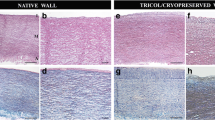Abstract
We determined how long cryopreserved aortic, pulmonic, mitral, and tricuspid valve homografts could be stored in a deep freezer (−80°C) without compromising fibroblast viability. Valves harvested from 20 anesthetized mongrel dogs were grouped into nonfrozen control, frozen and stored in liquid nitrogen (−196°C), and frozen and stored in a deep freezer (−80°C). Frozen groups were divided into subgroups and stored for 2, 4, 8, or 12 weeks. A leaflet of each valve was divided into three fragments, and fibroblast viability was analyzed by flow cytometry. Cell viability was defined as staining by fluorescent diacetate but not by propidium iodide. The viability of untreated control valves from all four sites was about 70%, decreasing to about 50% when treated with low doses of antibiotics. The viability of frozen valves stored in liquid nitrogen was about 45% without a significant difference among storage periods. The viability of valves frozen and stored in a deep freezer was significantly lower than for the liquid nitrogen group at 2 weeks for the mitral valve and at 4 weeks for other valves. These results suggest that homografts can be stored in a deep freezer for up to 2 weeks without deterioration.
Similar content being viewed by others
References
Barratt-Boyes BG, Roche AHG, Whitlock RML. Six-year review of the results of freehand aortic valve replacement using an antibiotic sterilized homograft valve. Circulation 1997; 55: 353–61.
O’Brien MF, McGiffin DC, Stafford EG, Gardner MAH, Pohlner PF, McLachlan GJ, et al. Allograft aortic valve replacement. long-term comparative clinical analysis of viable cryopreserved and antibiotic 4°C stored valves. J Card Surg 1991; 6 (Suppl 1): 534–43.
Berghuis J, Van Vliet PD, Titus JL, Swan HJC, Ellis FH Jr. Homotransplantation of the Caine mitral valve. Circulation 1964; 29 (Suppl 1): 47–53.
Acar C, Farge A, Ramsheyi A, Chachques JC, Mihaileanu S, Gouezo R, et al. Mitral valve replacement using a cryopreserved mitral homograft. Ann Thorac Surg 1994; 57: 746–8.
Acar C, Tolan M, Berrebi A, Gaer J, Gouezo R, Marchix T, et al. Homograft replacement of the mitral valve — graft selection, technique of implantation, and results in forty-three patients. J Thorac Cardiovasc Surg 1996; 111: 367–80.
Brockbank KGB, Carpenter JF, Dawson PE. Effects of storage temperature on viable bioprosthetic heart valves. Cryobiology 1992; 29: 537–42.
Feng XJ, Van Hobe CEJ, Walter PJ, Herman AG. Effects of storage temperature and fetal calf serum on the endothelium of porcine aortic valves. J Thoracic Cardiovasc Surg 1996; 111: 218–30.
Endl E, Steinbach P, Schärfe J, Fickweiler S, Wörle K, Hofstädter F. Cell-type-specific response to shock waves of suspended or pelleted cells as analysed by flow cyctometry or electrical cell volume determination. Ultrasound in Med. & Biol. 1996; 22: 515–25.
Jones KH, Senft JA. An improved method to determine cell viability by simultaneous staining with flourescein diacetate-propiduim iodide. J Histochem and Cytochem 1985; 33: 77–9.
Niwaya K, Sakaguchi H, Kawachi K, Kitamura S. Effect of warm ischemia and cryopreservation on cell viability of human allograft valves. Ann Thorac Surg 1995; 60: s114–7.
Lockey E, Janabi NAI, Lavin LG, Ross DN. A method of sterilizing and preserving fresh allograft heart valves. Thorax 1972; 27: 398–400.
Lavin LG, Janabi NAI, Lockey E, Ross DN. Fibroblast viability in antibiotic-treated valves. NZ med J 1973; 77: 36–9.
Crescenzo DG, Hilbert SL, Barrick MK, Corcoran PC, St. Louis JD, Messier RH, et al. Donor heart valves: electron microscopic and morphometric assessment of cellular injury induced by warm ischemia. J Thorac Cardiovasc Surg 1992; 103: 253–8.
Karow AM Jr. Biophysical and chemical considerations in cryopreservation. In: Karow AM Jr, Pegg DE ed. Organ Preservation for Transplantation. New York: Marcel Dekker Inc., 1981: 113–41.
Takahashi T. Freezing injury of animal cell and mechanism of protective action of cryo-protectants. In: Sakai A, ed. Cryopresevation. Tokyo: Asakura Shoten, 1987: 15–23.
Dowell LG, Rinfret AP. Low-temperature forms of ice as studied by X-ray diffraction. Nature 1960; 31: 1144–8.
Author information
Authors and Affiliations
Rights and permissions
About this article
Cite this article
Kashima, I., Yozu, R., Shin, H. et al. Effect of storage temperature on cell viability in cryopreserved canine aortic, pulmonic, mitral, and tricuspid valve homografts. Jpn J Thorac Caridovasc Surg 47, 153–157 (1999). https://doi.org/10.1007/BF03217961
Received:
Accepted:
Issue Date:
DOI: https://doi.org/10.1007/BF03217961




